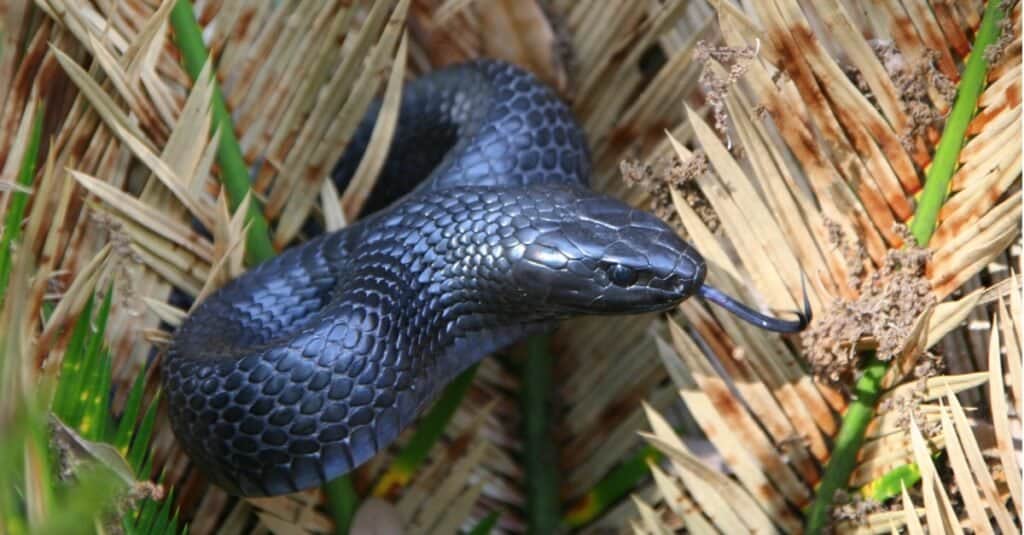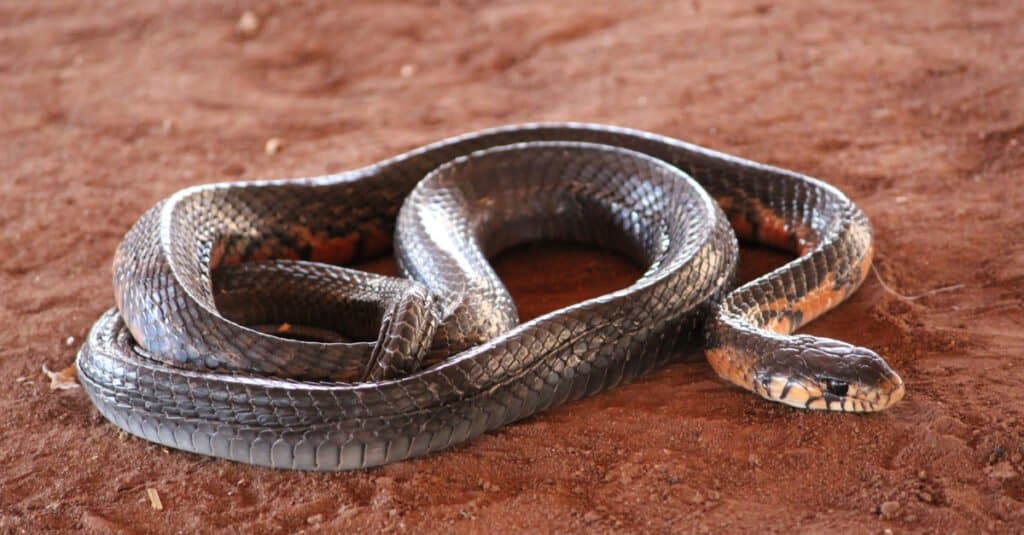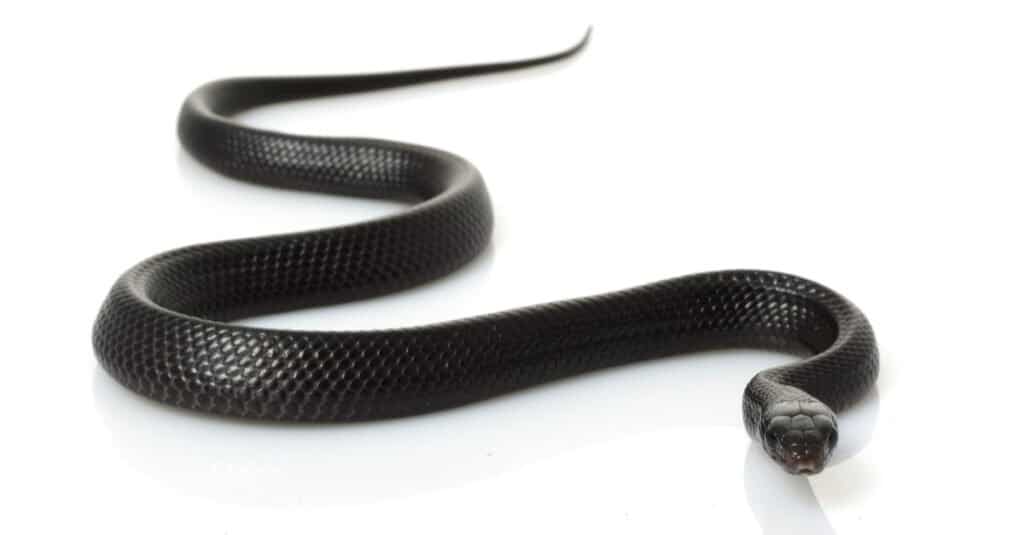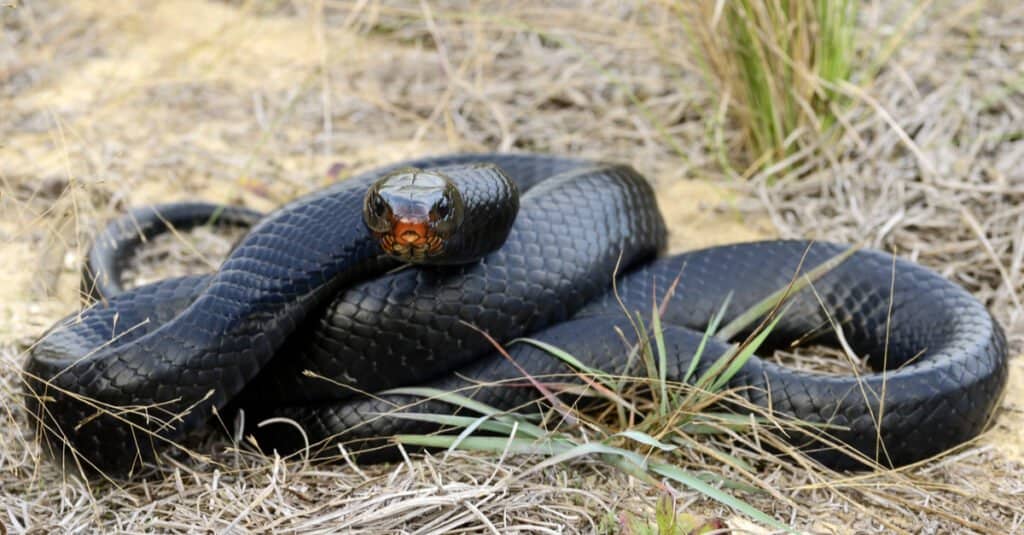The 2022 discovery of an Eastern indigo snake in Alabama is very exciting since there has only been one other Eastern indigo snake observed in the state since 1954.
Eastern Indigo snakes disappeared from Alabama nearly 60 years ago, but scientists and conservationists have been working with the Eastern Indigo Project to bring them back to the state.
Why Are Eastern Indigo Snakes So Rare in Alabama?

Eastern indigo snakes were sought after by pet traders owing to their docile nature.
©iStock.com/sstaton
Eastern indigo snakes are one of the largest North American snakes, reaching lengths of up to 8 feet long. They are native to the southeast United States, and once thrived in the state of Alabama. However, in the 1950s Eastern indigo snakes completely disappeared from Alabama, primarily because of habitat loss and human persecution.
Additionally, because of their docile nature, domestic and international pet traders collected these snakes (which is now illegal). Furthermore, rattlesnake collectors would (illegally) gas gopher tortoise burrows in hopes of collecting snakes and end up accidentally killing many Eastern indigo snakes as well.
Today, the Eastern indigo snake is a federally threatened species and is protected by federal and state laws.
To even interact with an Eastern indigo snake in Alabama requires a legal permit — assuming you can find one of these snakes. For the past 60 years or so, sightings of Eastern indigo snakes in Alabama were unheard of. This is why this most recent discovery is great news!
An Exciting New Discovery
The recently discovered Eastern indigo snake was reported in March 2022 by Francesca Erickson, a grad student conducting a survey in the Conecuh National Forest in Southern Alabama.
She reported that the snake was about a foot long and probably less than a year old.
The snake did not have a tracker on and was much smaller than the snakes released by conservationists, which are usually five feet or longer. The Alabama Wildlife and Freshwater Fisheries Division confirmed that this snake “is the product of natural pairings among those purposely released in Conecuh National Forest.”
The first wild-hatched snake found in Alabama was discovered in 2020. The discovery of this second snake suggests that the Eastern indigo snake is finally establishing itself in Alabama and breeding.
On their Facebook page, the Alabama Wildlife and Freshwater Fisheries Division explained that this second snake “indicates that the project is resulting in some thriving and reproducing indigos – just what we wanted! Reintroducing a species to its native range is a daunting task, and we celebrate each step of its success!”
Where is Conecuh National Forest Located on a Map?
The Conecuh National Forest is situated in the southern part of Alabama, United States. It spans several counties, including Covington, Escambia, and Geneva. To get there from Montgomery – the capital city of Alabama – one can take I-65 S to AL-55 S in Evergreen for approximately 90 miles before exiting at exit 96 towards Andalusia/Luverne. From there, continue on AL-55 South for about 20 miles until reaching the forest’s entrance.
On a map, visitors can locate Conecuh National Forest by searching for it within its designated boundaries indicated by a green patch with boundary lines surrounding it. The forest encompasses an area of approximately 84 thousand acres and offers diverse recreational opportunities such as hunting, fishing, and camping, among others.
Why Are Eastern Indigo Snakes Being Reintroduced Into Alabama?

Efforts to bring the Eastern indigo snake back to Alabama have been ongoing for more than a decade.
©Patrick K. Campbell/Shutterstock.com
The Eastern indigo snake is an important apex predator in long-leaf pine ecosystems. In Alabama, this snake helps to keep these ecosystems balanced.
Eastern indigo snakes are carnivorous and eat turtles, turtle eggs, lizards, toads, frogs, fish, small alligators, small birds, and other snakes. They even eat venomous snakes like cottonmouths and rattlesnakes!
The Eastern Indigo Project began reintroducing Eastern indigo snakes in 2010, hoping to re-establish a viable population in Alabama. Their goal is to release 300 snakes over the course of several years (approximately 30 snakes a year).
Alabama is not the only state where Eastern indigo snakes are being re-introduced. For the past six years, they have been released in batches in northern Florida, for a total of 107 so far.
And Georgia is teaming up in the efforts. Zoo Atlanta has been responsible for raising more than 100 of the Eastern indigo snakes that were reintroduced in Alabama. Hopefully, populations will slowly continue to grow.
What Does the Eastern Indigo Snake Look Like?

Some Eastern Indigo Snakes have cream or orange-colored scales on their cheeks, chin, and throat.
©Alan Jimenez G/Shutterstock.com
The Eastern indigo snake’s name comes from its unique blue-black, glossy scales. In the light, these scales have an iridescent shine that appears purple. Some of these snakes may also have a red or creamy color on the chin, throat, and cheeks.
Eastern indigo snakes grow to be around 5-7 feet long on average, although the longest one on record was 9 feet and 2 inches long! The Eastern indigo snake is the longest snake native to the United States.
These snakes are diurnal, so they are active during the day and sleep through the night.
Where Do Eastern Indigo Snakes Live?

The Eastern indigo snake can be found mainly in Florida, Georgia, and Mississippi.
©fivespots/Shutterstock.com
The Eastern indigo snake is native to the southeastern United States. It lives in the Florida peninsula, Georgia, and a small part of southeastern Mississippi. It once thrived in Alabama as well, but for more than 60 years there have only been two sightings in the state.
This snake species uses a variety of habitats depending on the season, including pine, sandhills, marshes, freshwater, prairies, and burrows.
When it gets cold in the winter, the Eastern indigo snake relies on gopher tortoise burrows to stay warm.
As a matter of fact, these snakes actually cohabitate with gopher tortoise colonies throughout the winter! When it warms up in the spring, the snakes resurface and move several miles away from their winter refuge.
Because their habitat changes depending on the season, Eastern indigo snakes need access to natural corridors. When humans split up their environment, it is very difficult for these snakes to thrive.
How Long Do Eastern Indigo Snakes Live For?
It’s difficult to say how long this snake species lives due to the lack of information on its lifespan in the wild.
We do know that the oldest recorded Eastern indigo snake in captivity was aged 25 years and 11 months, and other estimates of its lifespan in captivity range from 17 to 26 years.
Are Eastern Indigo Snakes Dangerous?

Eastern indigo snakes are not venomous but do eat venomous snakes.
©Patrick K. Campbell/Shutterstock.com
Eastern indigo snakes are not dangerous! Although they may appear intimidating, these snakes are not venomous or aggressive.
In fact, Eastern indigo snakes are extremely docile, and even when they are picked up, they rarely bite. When it feels threatened, an Eastern indigo snake will hiss and flatten its neck while vibrating its tail, and may bite and emit a foul-smelling musk from their cloaca.
Eastern Indigo Snake vs Rat Snake
While this snake species is not considered dangerous to humans, it is a definite threat to its prey. Eastern indigo snakes are carnivores and prefer consuming reptiles, including most venomous snakes in their habitat. These snakes will eat pretty much anything that they can swallow — and they will often swallow it whole while it is still alive. That’s certainly the case when it comes to this video showing an Eastern indigo and a rat snake.
When the rat snake tries to escape capture, the indigo attacks, lunging from behind and begins swallowing the smaller snake head-first. It grips its prey, subduing it in its strong jaw. The Eastern indigo’s body swells as it swallows more and more of the rat snake, which gets shorter and shorter until only its tail is remaining — and then it’s gone. Watch all the action in the video here!
What Should I Do If I See An Eastern Indigo Snake?
If you happen to come across an Eastern indigo snake, do not interfere with it. Stop your activities and give the snake plenty of time to move from the area.
Do not try to touch it or move it yourself! The Eastern indigo snake is protected under federal and state laws.
However, if you can get a picture of the snake (safely, without harming yourself or disturbing the snake), please do!
The United States Fish and Wildlife Services, Alabama Wildlife and Freshwater Fisheries Division, and the Eastern Indigo Project would love documentation to help them identify and track Eastern indigo snakes, especially in Alabama.
Animals in Alabama
While the Eastern indigo snake is extremely rare in Alabama, the state has many animals living within its borders that are much more easily spotted. There are more than 4,500 species in Alabama, including 433 bird species — some of which are among the rarest on the planet.
Among the 22 species of rodents are gray squirrels, fox squirrels, chipmunks, and southern flying squirrels. Predators that live in the state include bobcats, coyotes, red foxes, and gray foxes.
Alabama’s official state animal is the North American black bear, which was once rare but the population has increased in recent years. With this new sighting of an Eastern indigo snake and the work that scientists and conservationists have been doing to reintroduce them to the state, there is hope that perhaps this species’ numbers will grow again, too.
The photo featured at the top of this post is ©
Discover the "Monster" Snake 5X Bigger than an Anaconda
Every day A-Z Animals sends out some of the most incredible facts in the world from our free newsletter. Want to discover the 10 most beautiful snakes in the world, a "snake island" where you're never more than 3 feet from danger, or a "monster" snake 5X larger than an anaconda? Then sign up right now and you'll start receiving our daily newsletter absolutely free.
Thank you for reading! Have some feedback for us? Contact the AZ Animals editorial team.






